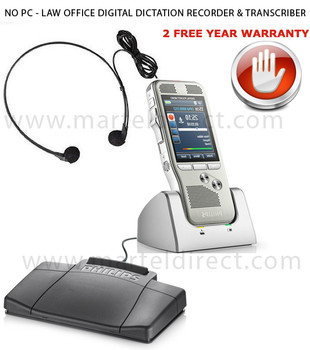The Evolution and Impact of Dictation Equipment: From Analog to Digital
In the realm of communication and documentation, the evolution of dictation equipment has been transformative. What began as rudimentary voice recording devices has evolved into sophisticated digital systems that not only capture speech but also facilitate seamless integration with various technologies. This article delves into the journey of dictation equipment, exploring its historical significance, technological advancements, practical applications across different fields, and the future trends that promise to further revolutionize this essential tool of modern communication.
I. Historical Perspective: From Voice Recorders to Dictation Machines
Dictation equipment has its roots in the early 20th century when Thomas Edison patented the first phonograph in 1877, marking a pivotal moment in the recording of sound. However, it was not until the mid-20th century that specialized dictation machines began to emerge. These machines, initially analog, enabled professionals such as doctors, lawyers, and executives to dictate notes and correspondence efficiently.
Analog Era:
- Dictaphones and Tape Recorders: Devices like the Dictaphone cylinder phonograph (1907) and magnetic tape recorders (1940s) revolutionized dictation practices. They allowed for the direct recording of spoken words onto physical media, enhancing the speed and accuracy of transcription.
- Microcassette Recorders: Introduced in the 1960s, microcassette recorders provided a compact alternative to larger tape-based systems, becoming popular among professionals for their portability and ease of use.
Transition to Digital:
- Digital Voice Recorders: In the late 20th century, digital technology began to replace analog systems. Digital voice recorders offered superior sound quality, longer recording times, and the ability to transfer recordings to computers for transcription and storage.
- Integration with Computers: The integration of dictation software with personal computers in the 1990s further streamlined the dictation process, allowing for real-time transcription and editing.
II. Technological Advancements: Digital Revolutionizes Dictation Equipment
The advent of digital dictation equipment brought about significant improvements in terms of functionality, usability, and integration with other technologies. Key technological advancements include:
Speech Recognition Software:
- Natural Language Processing (NLP): Advances in NLP have enabled the development of sophisticated speech recognition algorithms capable of accurately transcribing spoken words into text.
- AI and Machine Learning: Machine learning algorithms enhance the accuracy and adaptability of speech recognition systems, learning from user inputs to improve transcription quality over time.
Cloud-Based Solutions:
- Remote Access and Collaboration: Cloud-based dictation systems allow users to access recordings and transcripts from anywhere, facilitating remote work and collaboration among teams.
- Scalability and Storage: Cloud storage offers virtually unlimited capacity for storing recordings and transcripts, eliminating the need for physical media and enabling scalable solutions for businesses of all sizes.
Dictation Equioment Recorders Integration with Workflow Management Systems:
- Automation and Efficiency: Integration with workflow management systems automates the distribution and processing of dictations, improving efficiency and reducing turnaround times for transcription.
- Customization and Personalization: Users can customize dictation workflows to suit specific needs and preferences, enhancing productivity and user experience.
III. Dictation equipment plays a crucial role Applications Across Industries: Enhancing Productivity and Efficiency
Dictation equipment plays a crucial role across various industries, transforming workflows and enhancing productivity through streamlined communication and documentation practices.
Healthcare:
- Medical Transcription: Doctors and healthcare professionals use dictation equipment to record patient notes, medical histories, and treatment plans, which are then transcribed by medical transcriptionists or speech recognition software.
- Compliance and Documentation: Dictation ensures accurate and timely documentation of patient encounters, supporting compliance with healthcare regulations and standards.
Legal Profession:
-
Legal Dictation: Lawyers dictate case notes, briefs, and correspondence, which are transcribed and archived for legal documentation and case management purposes.
-
Time Management: Efficient dictation workflows enable lawyers to manage their time effectively, focusing on core legal tasks while delegating transcription to support staff.
Business and Corporate Environments:
- Executive Communication: Business executives use dictation equipment to dictate memos, reports, and strategic plans, improving communication within organizations and enhancing decision-making processes.
- Meeting Transcription: Digital dictation systems facilitate real-time transcription of meetings and discussions, ensuring accurate capture of key decisions and action items.
IV. Dictation Equipment Future Trends and Innovations: Towards Smarter, More Integrated Systems
Looking ahead, the future of dictation equipment promises further advancements driven by emerging technologies and changing user needs.
Artificial Intelligence and Contextual Understanding:
- Context-Aware Systems: AI-powered dictation systems will become more adept at understanding context and user intent, improving transcription accuracy and efficiency.
- Multimodal Integration: Integration with other modalities such as video and images will enable comprehensive documentation of multimedia content.
Internet of Things (IoT) Integration:
- Smart Devices: IoT-enabled dictation devices will offer seamless integration with other smart devices and applications, enhancing user convenience and accessibility.
- Voice-Activated Systems: Voice-activated dictation systems will become more prevalent, offering hands-free operation and improved user interaction.
- Enhanced Security and Privacy:
- Data Encryption: Advanced encryption technologies will ensure the security and privacy of dictation data, particularly in industries such as healthcare and legal where confidentiality is paramount.
- Compliance with Regulations: Dictation equipment will continue to evolve to meet stringent data protection regulations and compliance requirements worldwide.
V. Conclusion: The Continuing Evolution of Dictation Equipment
In conclusion, dictation equipment has evolved from its humble beginnings as analog voice recorders to sophisticated digital systems that integrate AI, cloud computing, and IoT technologies. These advancements have revolutionized communication and documentation practices across industries, enhancing productivity, efficiency, and accuracy. As technology continues to evolve, the future of dictation equipment holds promise for even smarter, more integrated systems that will further streamline workflows and empower users across the globe. Whether in healthcare, legal, business, or beyond, dictation equipment remains an indispensable tool for capturing, transcribing, and managing spoken communication in the digital age.
As we look to the future, the evolution of dictation equipment stands as a testament to the ongoing innovation and adaptation shaping the way we communicate and collaborate in an increasingly interconnected world.







